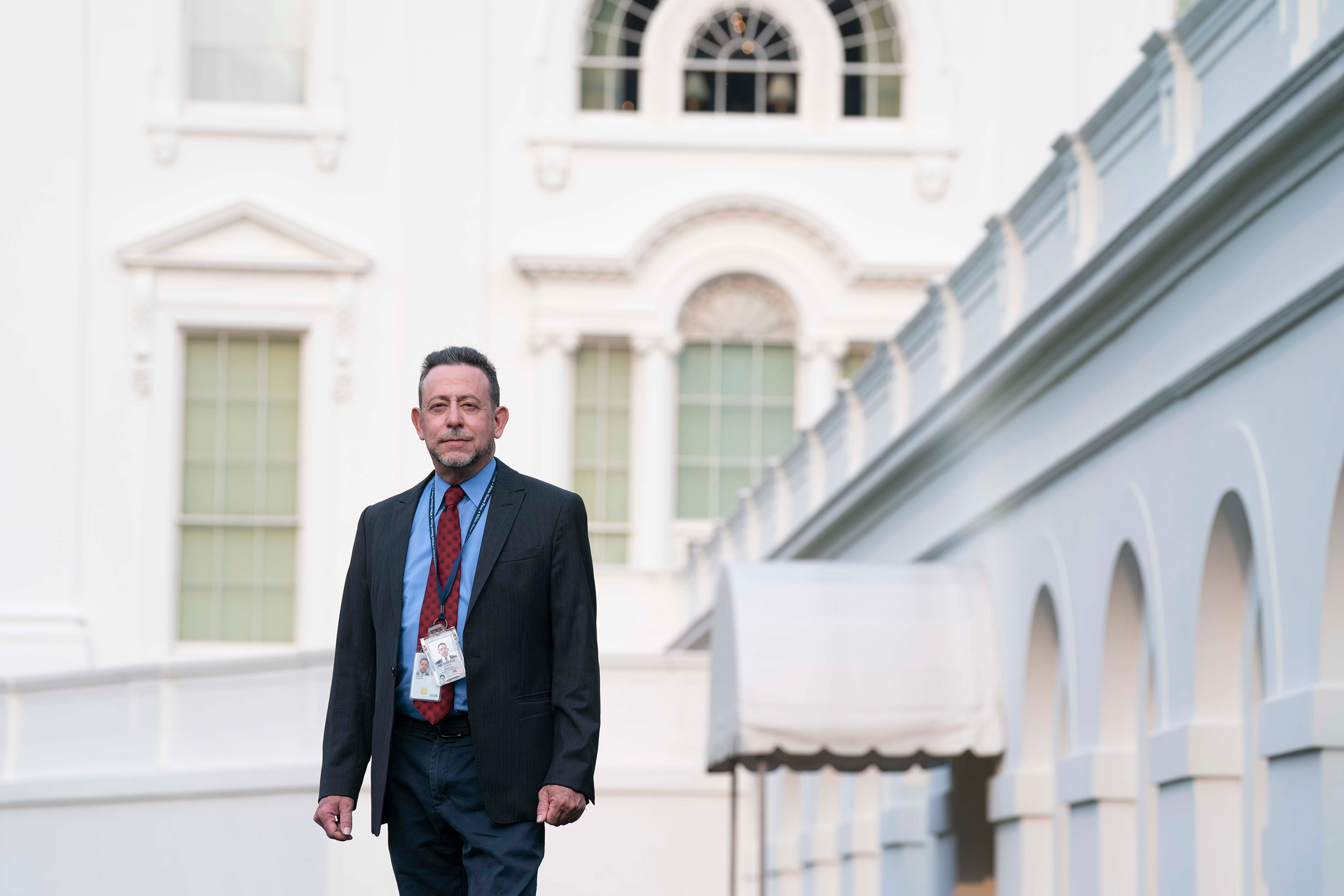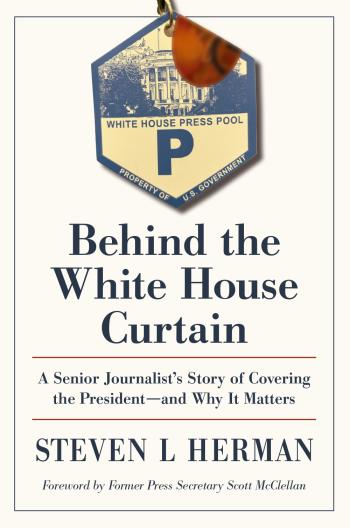Issue:
March 2024
An extract from Steven L Herman’s Behind the White House Curtain: A Senior Journalist’s Story of Covering the President—and Why It Matters, coming from Kent State University Press in June.

The ultimate privilege of traveling with the president is flying on Air Force One. After dozens of trips on the big bird, however, I can attest it is a mixed blessing.
Those designated as poolers for the flights find their own way to Joint Base Andrews in Camp Springs, Maryland, a 12-mile drive from the White House. The president usually makes the trip in minutes on Marine One, escorted by two other Marine Corps helicopters. But if there is a weather call, then a motorcade, which includes a pair of press vans, is hastily arranged. The journalists who will fly on the plane are to report hours prior to takeoff at the base. They are welcome to drive their own vehicles onto the grounds of the military facility. There is also free parking convenient to the terminal for the duration of the trip – be it half a day or two weeks. When journalists arrive on base, they create their own escorted motorcade with hazard lights blinking but, unlike the presidential motorcade, observe all traffic signals and stop signs.
As a frequent traveling pooler, I was issued a Defense Biometrics Identification System (DBIDS) card to show at the guard post, allowing me to drive directly to the terminal. Subsequent to the perfunctory flashing of credentials to get onto the base, there is a more rigorous screening after the press corps enters the terminal. Like at a civilian airport, our bags pass through a scanner and we walk through a metal detector. There is a second screening for our bags and bodies.

The Secret Service’s PPD calls out the dogs. One canine, actually, who sniffs all the media’s equipment, which we line up on the floor for an olfactory inspection. After the dog has left, the journalists are “wanded”. A PPD agent uses a handheld metal detector as we stretch out our arms and hold our wallets and cell phones.
There is usually a brief waiting period before we are escorted on foot to the tarmac. I snap a photo of the plane on my cell phone and email it to the pool. I make sure that the tail number of the aircraft is visible. This ensures that the media knows which Air Force One the president will be on.
Any fixed-wing US Air Force aircraft the president is flying on is Air Force One, which is an aviation radio call sign. The vice president’s plane is Air Force Two. If the president’s spouse is flying solo, that plane is Executive One Foxtrot.
The aircraft type and call sign occasionally are newsworthy. On October 17, 2018, First Lady Melania Trump’s plane was forced to return to Andrews because of smoke in the cabin. There was initial confusion as to what type of aircraft she was on as none of the reporters on board had sent out that information prior to takeoff. That’s why I suggested to other radio poolers when they have travel duty to always note the plane’s tail number.
The two big planes best known as Air Force One – with tail numbers 28000 and 29000 – are highly modified Boeing 747-200Bs. The Air Force designates these planes as VC-25As. Fully fueled, they each weigh 833,000 pounds at takeoff. It costs taxpayers $200,000 an hour to operate the big planes. For the shorter flights, a modified Boeing 757-200 is used (designated by the Air Force as a C-32). In all, there are four of these planes operated by the 1st Airlift Squadron of Andrews’s 89th Air- lift Wing.
The final step of the boarding process for the press occurs at the back stairs. A member of the US Air Force ticks our names on a list, checking it against our presented identification. And with that we climb the steps, turn left, and find our assigned seat on which is usually placed a card with our surname.
As the radio pooler I was in the press cabin’s third-row aisle seat, next to the Associated Press photographer, who had the window seat. The photographers will have an uneventful trip as they are permitted to take pictures in the plane only when there is a news conference, which TV can also tape.
Most of the time the media events, be they with the president, members of his Cabinet, other VIPs, or the press secretary, are either off the record (nothing can be used), on background (only attributed to a “senior White House official”), or an on-the-record “gaggle”.

During a gaggle we can record audio (but not video), meaning that the radio pooler’s recording is precious. It sounds straightforward, but there can be confusion. Some presidents have generally eschewed speaking to reporters on the plane. Some prefer to keep it off the record and let their hair down, so to speak. (Lyndon Johnson was known for his coarse language, which could have never been used verbatim in the media of his time.) Trump frequently caused momentary panic for press aides and confusion among journalists when coaxed by a persuasive reporter to transform a not-for-publication comment into paragraphs that were releasable. Unless I was specifically prohibited on the plane, I kept a microphone near the president and a device recording the audio.
Occasionally a bored photographer notices something unusual out the window as occurred on one return into Andrews when we spotted another military aircraft buzzing alarmingly close to Air Force One. Before I could blink, the still photographers had clicked their motor drives, capturing the other plane zooming by.
Another big difference between a commercial flight and Air Force One is the departure procedure. After we board, most of us quickly get back off the plane. We perch under the wing to watch the president arrive via Marine One or motorcade and try to lure him over for an impromptu question-and-answer session.
For most presidents, most of the time, it’s a quick boarding with a salute to the Air Force personnel and a ceremonial wave at the top of the front steps. But from time to time there are remarks under the wing to the waiting poolers before he boards.

Once the president steps inside, we quickly head back up the rear stairs. For the pool this is a very intense next few minutes if the president has spoken. I rush to upload the audio with a quick file transfer to my computer, using a cell phone signal for the upload to the internet. The photographers send their pictures of the president, and the print and wire poolers file a quick report. This all works when we are on the modified 747s. But the newer, smaller planes are a virtual Faraday cage and we have no cell phone service inside. On those aircraft I huddle at the top of the stairs to beam material in the last few seconds before we are forced inside so the doors can be closed.
When the president is in his seat, the plane will quickly start rolling and we must be in our seats as well, although the flight attendants rarely check for unbuckled belts and seat positions unlike what every commercial flyer experiences. After takeoff there is no self-introduction from the pilot and no friendly chitchat about our flight path or the weather.
Until the Reagan administration, passengers on Air Force One received complimentary cigarettes and were free to light up.
The cigarettes have given way to boxes of presidential M&Ms. One legacy remains from those carcinogenic flights: presidential matchbooks. We are allowed to use our cell phones during takeoff, but we lose all the signal bars quickly as the jet ascends. Reporters use this brief window of time at low altitude to send a “wheels up” message to their respective pools, noting the precise moment the aircraft lifts from the runway.
Most Air Force One flights are domestic in destination, frequently involving a return to Joint Base Andrews the same day. Presidents, of course, do sometimes travel overseas. For those international trips there is usually a refueling stop – ideally at a US military base. When we went from the Group of Seven meeting in Canada to the first summit with Kim Jong Un in Singapore, the plane departed the Canadian Forces Base at Bagotville in Quebec with a gas stop at 3 a.m. local time at the Souda Bay military base on the Greek island of Crete. Most of us disembarked for a middle-of-the-night off-the-record informal chat with a senior administration official under the port-side wing of the plane during the refueling.
Extended time on Air Force One is grueling for officials, the crew, and journalists, who find themselves working during the flight. For example, the trip from Canada to Singapore exceeded 17 hours. The president has the luxury to snooze fully horizontal in his private cabin, wake up refreshed, and begin a full day on arrival as he did on the flight from North America to Asia. The rest of us, who also need to hit the ground running, try to find a way to get some time napping in flight. For the journalists this is challenging since no one wants to sleep through an unplanned visit to our cabin from the president, a Cabinet member, or the press secretary. Although no one can say for certainty what the president will do in flight, I try to ascertain from one of the press officials on board whether the president is going to leave us alone.
Embarrassing incidents for the media (and others) on board Air Force One have occurred in the lavatories, with phones accidentally dropped into the toilets. The bathroom amenities are excellent – on par with commercial business class. There are soaps, antibacterial gels, skin lotions, toothpaste and toothbrushes, razors, plush recyclable hand towels, and mouthwash. No one wants to have bad breath when face-to-face with the president.
Steven L Herman is the chief national correspondent of the Voice of America, the JURIST journalist-in-residence at the University of Pittsburgh School of Law and an adjunct lecturer in journalism at the University of Richmond. Steve served as FCCJ president on the 1997-98 board and is a life member of the club.

